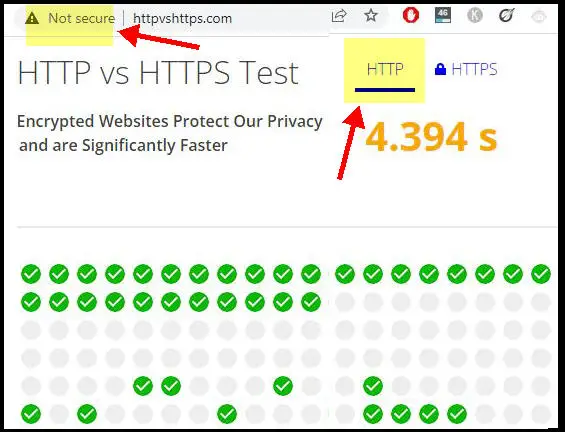SSL adds some lag when users visit your website. However, the protocol usually increases the overall page speed of your website.
Industry tests show that websites are up to four times faster using the SSL protocol instead of the older HTTP protocol.
Unfortunately, some circumstances lead to SSL adding up to eight seconds to your page load time. These are specific problems that you should fix!
This article explains:
- why SSL adds some lag to your website
- proof that SSL increases the overall speed of websites
- why SSL makes your website faster
- how to fix special circumstances when SSL makes your website slower
Table of Contents
Why Does SSL Add Some Lag To Your Website?

When someone clicks on a link that goes to one of your web pages, their browser sends a request for the contents and your website sends back a response.
By adding SSL to your website, the requests and responses are encrypted. This protects both the websites and every internet user.
But the undoubted benefits of encryption also come with a drawback: extra work must be done by your website to encrypt the content sent out to a browser.
I won’t go into the details of encryption, but I’ll say here that the extra work includes:
- An extra request-response trip between the browser and your website to establish trust
- Exchanging a long encryption key
- Adding encryption to the connection
Let’s say that we are comparing http://www.acme.com and https://www.acme.com.
If everything else was the same, then browsing the SSL version should be a little slower due to the extra work done to encrypt the connections.
However, all industry-standard tests show that HTTPS sites (sites with SSL) are faster than HTTP sites (sites without SSL).
Before I explain why let’s take a look at one of these industry tests.
Proof That Having SSL Does Not Slow Down Websites
One of the most well-known tests was devised by a software engineer to compare load times for a web page with a grid of 360 images.
He has two versions of the same page – one is HTTP and one is HTTPS.
If you want to try the test yourself, go to this web page and toggle between the “HTTP” and “HTTPS” links at the top right.
This image captures the HTTP version in “mid-run”. You can see that at 4.3 seconds, only some of the images have loaded.

For me, the full non-SSL page took over 12 seconds to complete.
The next step is to click the “HTTPS” link to open the SSL version. When I ran the test, this version took a little over 4 seconds to fully load.
In other words, my test results found that having SSL made the web page three times faster.
Given that we know that SSL makes the website do extra work for encryption, how can this be? Let’s look at why in the next section.
How SSL Makes Your Website Faster
Although SSL adds an extra load to your website, the overall impact is to increase the page load speed.
This is because SSL allows you to use the HTTP/2 protocol, which is greatly improved over the old HTTP protocol of pre-SSL websites.
HTTP/2 uses compression to reduce the amount of data transferred between the browser and your website. This significantly increases the page speed.
The gain you get from the compression is far more than the tiny lag due to encryption.
Things To Check If You Think That SSL Is Slowing Your Website
Although we’ve shown that SSL should speed up websites in general, you may have hit a specific scenario where it is actually giving you performance issues.
Here are some pointers for troubleshooting.
Are you loading images from a non-SSL domain?
Website owners usually upload images to their host server to show on their web pages. On an SSL website, this means that the images are also being transferred via SSL.
However, sometimes we choose to embed an image hosted on another domain. Be careful if the source domain is an older website.
If it doesn’t have SSL installed, then your web page now has what’s known as “mixed content”. This means you are using the SSL protocol to link to an image over insecure HTTP.
This can drastically slow your web pages. Users may find it takes eight to ten seconds to load the page.
The fix here is to avoid linking to HTTP domains. Find an alternate image!
Are you using plugins that make calls to non-SSL sites?
This problem happens less often now that SSL has been around for many years.
Website owners used to find that the helpful plugin that they installed was adding calls to javascript hosted on insecure sites. This slowed down the loading of their websites.
If you suspect a plugin is causing the issue, then you should look at the page source of a web page. Check that external links are using the HTTPS protocol.
Are you not using .htaccess to redirect HTTP to HTTPS?

So, you’ve got SSL on your www.acme.com website. Check what happens when you explicitly put the HTTP version into your web browser i.e. http://www.acme.com.
Watch the address bar: you’ll see a momentary pause before the padlock appears.
The address bar probably hides the protocol being used. But if you click on it, you’ll see https://www.acme.com.
But hey! You entered the HTTP protocol specifically.
What’s happened is that the web address you entered has been redirected to the HTTPS version.
The question is – how did this redirect occur? This can be achieved in several ways.
The fastest way to get this redirection is to add an entry to the .htaccess file on your server.
There are WordPress plugins that will also make this redirect happen. However, using a plugin will be slower than using the .htaccess method.
If you’re not sure about messing around with this important file, then a good hosting provider will set it up for you.
I use HostArmada for most of my websites. When I want to create a new one, I send them simple instructions that include setting up the HTTP redirect via .htaccess.
What Else Could Be Slowing Down Your Website?
Check out these articles: